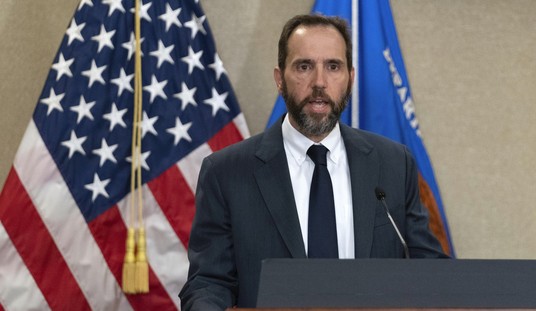Imagine Homer Simpson sitting like one of the alphabet network's talking heads, announcing the discovery of a record-breaking bolt of lightning: "Whoa! The sky farted electricity across, like, five states! And some nerds with space TVs finally figured it out... eight years later. D’oh!"
Science starts sounding like science fiction when saying it out loud: One bolt of lightning, only one, traveled 515 uninterrupted miles, stretching from the western edge of Texas, skimming Louisiana, and finally fading somewhere in Mississippi. It's roughly the same distance as driving from Chicago to Pittsburgh, or if you're on the coast, Boston to Baltimore.
This strike wasn't part of a rolling front or a chain of strikes: It was a single electric thread drawn across the sky; a single electric thread drawn across the sky like nature, signing her name.
An agency within the U.N., the World Meteorological Organization (WMO), recently confirmed a 2017 lightning bolt as the longest ever recorded. The event remained hidden in plain sight until satellite evidence compelled scientists to take another peek.
Something remarkable to consider: This phenomenon was so immense that it required better technology to be believed. When we finally accept it, it's the kind of fact that slaps us in the face, reminding us we don't know nearly enough as we pretend to.
Nature still has secrets she hides right over our heads.
The Texas Bolt That Bent Reality
There weren't towers shattering, hillsides igniting, or people struck — thank God! However, the event broke a record that bordered on the impossible. The WMO used satellite data from the GOES-14 Lightning Mapper to see a single bolt of lightning stretching across three U.S. states in under seven seconds.
The technical term "megaflash" describes a horizontal electrical discharge spanning hundreds of miles that occurs above large storm systems. This "blink and you'll miss it" event happened on Oct. 22, 2017, during a convective storm complex blanketing the southern United States.
A megaflash is a giant bolt of lightning that travels huge distances from its origin point, said Randall Cerveny, a professor of geographical sciences at Arizona State University and a member of the WMO committee that confirmed the new record.
“It’s an incredibly strange phenomenon,” he said. “We only discovered them 10 years ago, when we could use a particular set of technologies to detect the start and end locations of the of lightning events.”
Megaflashes are not altogether uncommon, but they typically only occur in parts of the world where specific geographical and atmospheric conditions can produce the most severe thunderstorms, Cerveny said. In the Great Plains and across the Midwest, for instance, warm and humid air from the Gulf of Mexico collides with drier, colder air from the north, creating strong atmospheric instability.
It took nearly eight years for the WMO to officially declare it the longest single lightning flash, surpassing the previous record of 477 miles set in 2020 in Brazil. The organization utilized a satellite-derived method known as the Maximum Great Circle distance technique, applied to archived lightning mapping data. When verified, the seven-second bolt reached an astounding 515 miles.
When thinking of lightning, we think of a cacophony of noise, flash, and crash, followed by a loud silence. Megaflashes, however, challenge that thought, because they're not short jabs; they're long, sinuous, glowing ropes stretching across the heavens, defying what we thought lightning could be.
A Lesson in Delayed Realization
There's something poetic about the discovery's delay: The bolt occurred during President Donald Trump's first term and wasn't confirmed until months into his second. It's a real-life reminder of what Victor Davis Hanson underscores: History doesn't always recognize itself in real-time. Sometimes, truth strolls in late, quiet, and with satellite printouts and lab-verified humility.
Science finally caught up to the sky in nearly eight years.
Why the delay? Technology needed to catch up. Before the GOES satellites, we didn't have the bird's-eye tools to even spot such a vast event. Ground-based lightning detection networks simply can't track cloud-to-cloud superstrikes over a range of that size. Until engineers and atmospheric physicists began reviewing old satellite data, they had no idea that something record-breaking had been overlooked.
It wasn't just there, sitting in archives; it was too big for our minds and tools to fully comprehend.
From Myth to Measurement: Lightning as God’s Wrath
For centuries, cultures have believed that lightning represented divine judgment. Each culture had its own name for the sky's fury: Zeus, Thor, or Yahweh. The mortal named Benjamin Franklin helped tame part of the myth using a kite and key, but it wasn't until the past few decades that scientists have begun mapping the whole terrain of the lightning world.
Still, 515 miles? D'oh! That's not a spark, that's an electrified version of the Mississippi River, a divine underscore across the American South.
Imagine a rancher outside Lubbock that night, watching a storm miles away with no rain or overhead thunder. Out of nowhere, a streak of blue-white plasma rips across the sky atop the clouds like a ghost dragging its fingernails across Heaven.
No warning or explanation, just awe.
The Bolt We Deserve
If you're looking for a metaphor for modern America, you could do worse than using this bolt. Enormous, largely visible, understood only after the fact. By the time we realized what we'd seen, it was over.
Doesn't that sound familiar?
We live in a country that's addicted to distraction, buried in noise. Yet, even in our loudest moments, nature still finds a way to whisper the profound. Not every story carries a human fatality; not every disaster screams for CNN coverage. Sometimes, the story quietly arrives, shakes its head at our self-importance, then vanishes into the humidity.
This event was represented by one of those.
Megaflashes, Megathreats, and Human Smallness
Typical lightning strikes hit the ground with blinding speed and fury. Megaflashes travel parallel to the ground, from cloud to cloud, stretching across atmospheric fault lines like celestial earthquakes, rarely killing, but they do warn.
According to the National Weather Service and WMO, megaflashes happen during large mesoscale convective systems, forming in flat terrain like the central U.S. and parts of South America. That's why Texas, Oklahoma, and Missouri are megaflash hotbeds.
Here's where danger appears from nowhere. People see clear skies above and assume they're safe. Then, out of the blue, lightning strikes 30 or even 50 miles away from the storm core. It's these "bolt-from-the-blue" events that catch hikers, athletes, and golfers by surprise.
Lightning doesn't recognize borders, nor does it ask permission. It reaches, connects, and rarely, rewrites what we thought possible.
When Records Fall, Arrogance Follows
There are always those in the media who quickly treat the megaflash as some quirky trivia item, turning it into a fun fact before a weather segment. But, it's far more than that; it's the story of nature, reminding everybody listening that it's in charge, while we sit, wallowing in our humility.
While activists scream about climate change every time there's a heat wave, they need to be reminded that not all extreme weather is manmade. Sometimes, it's ancient, majestic, untouched by political narrative. Like people, the Earth has moods, and sometimes those moods flare.
And in the span of a few seconds, it lights up half a continent.
There comes a time when we need to stop pretending we control everything. The sooner we realize that, the better.
But, of course, we'll never reach that point.
Final Thoughts
When a single bolt of lightning, stretching from Texas to Mississippi, streaks across the sky, it's more than a meteorological record; it's an upper-case message, not written in words, but amps. Nature always has the final word. And often, she speaks only once.
I hope you don't mind, but I thought since he opened this column, he should close it, too. Homer, in his own way, is also a force of nature.
“So like… this one lightning bolt went from Texas to Mississippi, and it wasn’t just zappy-zap weather stuff, it was, like, Mother Nature dropping the mic. Boom! One giant electric ‘shut up!’ And of course, the fancy news people missed it, ‘cause they were too busy yelling about stuff that doesn’t matter. Typical.”










